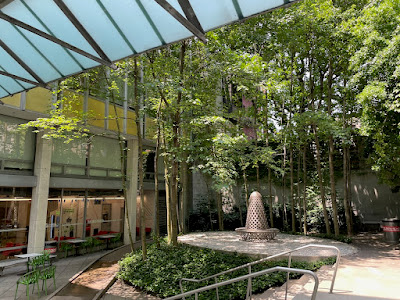Tuesday, July 01, 2025
Bicameral mayday
Saturday, June 28, 2025
SBMA
 Two works from the lovely Santa Barbara Museum of Art resonate with my experience bringing reflections on the religion of trees to the ISSRNC. On the one hand, it felt a little like the teeny tiny artist - painting a tree - oblivious to the all-enveloping weeping woman in David Alfaro Siqueiro's "The Aesthete in Drama" (1944); his canvas is about the size of each of her welling tears. Is focusing on trees irresponsible sentiment-ality in the face of climate catastrophe?
Two works from the lovely Santa Barbara Museum of Art resonate with my experience bringing reflections on the religion of trees to the ISSRNC. On the one hand, it felt a little like the teeny tiny artist - painting a tree - oblivious to the all-enveloping weeping woman in David Alfaro Siqueiro's "The Aesthete in Drama" (1944); his canvas is about the size of each of her welling tears. Is focusing on trees irresponsible sentiment-ality in the face of climate catastrophe?
ISSRNC
ISSRNC was good fun! This society, soon to celebrate its 20th anniversary, was established to add a social science dimension to emerging work on religion and ecology, as well as more attention to religion beyond the world religions, and is going strong. Perhaps a hundred anthropologists, philosophers, indigenous activists, development economists, literary scholars, geographers and ethicists and even a few theologians gathered to think together about our conference theme "Religion, Migration and Climate Change."
The International Society for the Study of Religion, Nature, and Culture was founded by the enterprising editor of the Encyclopedia of Religion and Nature, Bron Taylor, who is otherwise best known for arguing that our time is seeing the birth of a new science-friendly nature religion which he calls "dark green religion." Correlatively he has argued that the supposed ecological "greening" of older religions is superficial; as "agricultural" religions oriented beyond the natural world, the "world religions" cannot outgrow a fundamental suspicion of nature.
All of these themes were replayed in different ways during this conference. A Lifetime Achievement Award was offered to Catherine Albanase, the historian whose 1990 Nature Religion in America, 2008 A Republic of Mind and Spirit and 2023 The Delight Makers established a long-standing tradition of (settler) American "metaphysical" religion enthusiastic about the energies of nature and less connected to European traditions than imagined Asian and indigenous ones; the New Age turns out to be quite old, with lots of baggage. A special panel revisited the "Greening of Religions Hypothesis," work conducted a decade ago by Taylor and some collaborators analyzing 700 social scientific articles to determine if an environmental turn had moved the needle on established religions' indifference to nature: they found no significant progress in 2016, and report none since then either. But "Dark Green Religion" is alive and well in natural history and art museums!
Beyond this it was an intimately interdisciplinary and multigenerational gathering with papers on a plethora of parareligious subjects, from water spirits in Nepal and post-Christian pilgrimages to sites connected to Mary Magdalene to the theological meaning of the economists' category of the "resource curse," from something called critical surfing studies to the environmental devastation caused by successive enlargements of hajj facilities in Mecca to the religious imaginations of climate refugees in the Sundarbans and ICE detention. California butterflies, Indian Ocean sea turtles, struggling English cuckoos, the supposedly "de-extinctioned" dire wolf, and the soon to be extinct Virginia saltmarsh sparrows were mentioned too. (Someone talked about trees, too!)
An intellectual feast! And there was the optional excursion to Santa Cruz Island, too! But the overall mood was subdued. It's a tough time for religion, nature and culture. One keynote address bemoaned the incapacity of UN programs to take seriously the "intangible" religious loss and damage being caused by climate change. Another (which I missed but a friend told me about) reported on some Amazonian shamans' announcing that the world had had enough of human beings and we were all going to perish, although some of us might have a future reborn as other animals.
But then our conference was taking place in June 2025, when generations' worth of environmental progress is being aggressively scrapped in the US even as climate catastrophe approaches new tipping points globally - and when communities of researchers like us are under unprecedented assault by state and federal government pogroms. As green and even dark green religions stall, anti-environmental cults abound. When the long-awaited recognition of some mountains and rivers as legal persons came up, someone who studies Catholic traditions in West Virginia suggested the next question was who gets to appoint their legal representatives: someone might report that a given mountain was eager to share the mineral wealth God had filled it with. And the dark side of American "metaphysical religion," an ignorant mysticism of affirmations and whiteness, reigns in the White House.
This all makes interdisciplinary work on ecological relationships, environmental justice and the spiritual state of the planet that much more urgent. Our human and other than human kin need it desperately. "Religion" needs it too...
Friday, June 27, 2025
ISSRNC'd
Tuesday, June 24, 2025
Podcast blast from the past
Tuesday, June 17, 2025
New life
In the middle of the boneyard (and this photo), a new Torrey Pine rises!
Sunday, June 15, 2025
Saturday, June 14, 2025
Raising a flag
 What was the news from America today? A wannabe generalissimo wasted tens of millions from the public purse for a lackluster military parade while five million citizens gathered across the nation to decry the slide into authoritar-ianism. Huzzah!
What was the news from America today? A wannabe generalissimo wasted tens of millions from the public purse for a lackluster military parade while five million citizens gathered across the nation to decry the slide into authoritar-ianism. Huzzah!
But the day began with the awful news that two lawmakers in Minnesota, Melissa Hortman and John Hoffman, and their spouses had been shot in their homes by a vigilante assassin, impersonating police. Getting into what he took to be the spirit of the moment, maybe the murderer thought he'd be rewarded with a presidential pardon. His vehicle contained a list of dozens of other targets, as well as No Kings rallies. No faux-king way.
Thursday, June 12, 2025
Antibodies!
Wednesday, June 11, 2025
Military dishonor
Stationing the military in a US city (not to mention against the wishes of the city's mayor and the state's governor) is another unspeakable outrage. But the effort to coopt the military for white supremacy, which seems to be the agenda for this stage of the hostile takeover of the US, takes other terrible forms, too. We know about the ways the unqualified Secretary of Defense gratuitously fired generals who weren't white men. We know he has ordered the erasing of the military's long history of racial and gender inclusion.
And we knew that he was cynically restoring the names of military bases which had been stripped of the names of Confederate generals in response to the belated reckoning of BLM, dodging the law by finding other veterans who happened to have the same names to name them after instead - not that Bragg, that Hood, that Lee... nudge nudge wink wink.
I hadn't thought about the veterans whose names they were using to skirt the law; my bad. This is desecration of the memory of the dead. But the absolute obscenity of this became clear to me today on reading about the president's explicitly championing Confederate names at a military base yesterday (in front of a hand-picked military audience). I read that to rename a Virginia base originally named after Confederate general A. P. Hill they are stealing the names of three other veterans. Renamed Fort Walker two years ago after Civil War surgeon and Medal of Honor recipient Mary Walker, it is now to be named (nudge nudge wink wink) after three figures who fought in North Carolina for the Union: Pvt. Bruce Anderson from New York, 1st Sgt. Robert A. Pinn and Lt. Col. Edward Hill from Michigan. Call them "A. P. Hill" for short. Nudge nudge wink wink.
I'm at a loss for words to express my outrage at this. These were men who fought to defeat the Confederacy, now coopted to commemorate a Confederate general? Two of them just to provide initials for this travesty?! Grinding these men's names up to make a Confederate golem is horrifying, even before we learn that First Sergeant Pinn served in the Colored Infantry. How many of those nudging and winking know of this desecration, smile at the South sneakily rising again? Shameless, disrespectful of the dead and so vile vile vile ...
Monday, June 09, 2025
None of that
Thought we were done with the 'nones'? The latest analysis of the religiously unaffiliated in the US, who have been the subject of scrutiny and alarm for a dozen years now, proposes further subcategories with nifty names: 20% NiNOs, 36% SBNRs, 34% Dones, 10% Zealous Atheists.
Come "After Religion" next spring, we'll have to fold this analysis together with the story that religious disaffiliation has plateaued, the weird meme that this is because young men are going back to church, the claim that religion has become "obsolete" for US culture as a whole, and the latest Pew global religious landscape report, which swells the ranks of the unaffiliated by including most folks in China.

.jpeg)
.jpeg)
.jpeg)
.jpeg)
.jpeg)
.jpeg)







.jpeg)





